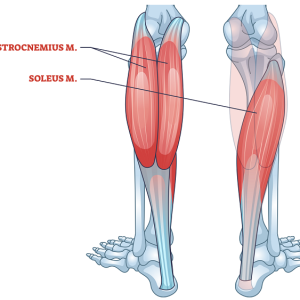Overview
The standing calf raise with dumbbell involves lifting onto the balls of your feet while holding dumbbells for added resistance. By incorporating dumbbells, the exercise intensity increases, effectively promoting muscular growth (hypertrophy), strength, and endurance in the calf muscles. Commonly incorporated into bodybuilding and general fitness routines, this exercise effectively strengthens and defines the lower-leg muscles, enhancing overall lower-body stability and muscular balance.
How to Perform Standing Calf Raise with Dumbbell

Starting Position: Stand upright with feet hip-width apart, holding a dumbbell in each hand, arms relaxed by your sides, maintaining proper posture and alignment.
Alignment and Stability: Engage your core muscles for stability, keep shoulders back, and maintain neutral spine alignment throughout the movement.
Lift Movement: Slowly rise onto the balls of your feet by lifting your heels as high as possible, fully contracting the calf muscles.
Controlled Lowering: Gradually lower your heels back down to the starting position in a controlled manner, ensuring steady muscular tension.
Repeat: Perform the desired repetitions, typically 10–15 reps per set, emphasizing slow and controlled movements.
Tips for Proper Form
Keep movements controlled, avoiding momentum or bouncing.
Maintain a neutral spine and upright posture throughout the exercise.
Hold briefly at the top position to maximize muscle engagement.
Select appropriate dumbbell weight to ensure proper technique and avoid injury.
Common Mistakes
Using Excessive Weight: Selecting overly heavy dumbbells can compromise form, reduce calf activation, and increase injury risk.
Limited Range of Motion: Not fully lifting heels or lowering them completely decreases effectiveness and muscle development potential.
Rapid, Jerky Movements: Fast repetitions or bouncing movements increase strain on tendons and joints, reducing exercise safety.
Benefits of the Standing Calf Raise with Dumbbell
Increases Calf Strength and Size Adding resistance with dumbbells effectively stimulates muscular hypertrophy, leading to stronger, more developed calf muscles.
Enhances Lower-Body Stability Strengthening calf muscles supports better ankle stability, improving balance, coordination, and injury prevention.
Improves Athletic Performance Essential for athletes, stronger calf muscles directly enhance running speed, agility, jumping height, and overall athletic capability.
Convenient and Adaptable Easily performed at home or gym, this exercise can be adjusted simply by changing dumbbell weight, catering to various fitness levels.
Promotes Lower Leg Circulation Regularly performing calf raises increases circulation, reduces fatigue, and accelerates recovery in lower legs and feet.
How to Incorporate Into Your Routine
For Beginners: Begin with 2–3 sets of 12–15 reps using lighter dumbbells, prioritizing controlled movement and proper technique.
For Muscle Growth (Hypertrophy): Perform 3–4 sets of 10–15 reps with moderate to heavy dumbbells, ensuring controlled tempo and full muscular contractions.
For Strength and Endurance: Include higher repetitions (15–20 reps per set) using moderate weight to build calf endurance and strength.
For Athletic Training: Integrate into lower-body or conditioning routines, performing 3–4 sets of 12–15 reps to enhance performance in sports involving running and jumping.
For General Fitness: Regularly include 2–3 sets of 10–15 repetitions weekly to maintain lower-leg muscular balance and health.
Muscles Worked

Frequently Asked Questions (FAQs)
How heavy should the dumbbells be for standing calf raises?
Choose weights that allow controlled, full-range repetitions (10–15 reps) without compromising form or balance.
How often should I perform this exercise for calf growth?
For optimal calf growth, include this exercise 2–3 times weekly, ensuring adequate recovery between sessions.
Can dumbbell calf raises replace machine calf raises?
While effective, combining dumbbell and machine exercises offers comprehensive muscle stimulation and overall calf development.
Are calf raises safe for beginners?
Yes, calf raises with lighter dumbbells and controlled form are safe and effective for beginners.
Can calf raises improve my running performance?
Strengthening calves significantly improves running power, endurance, speed, and reduces risk of injury.
